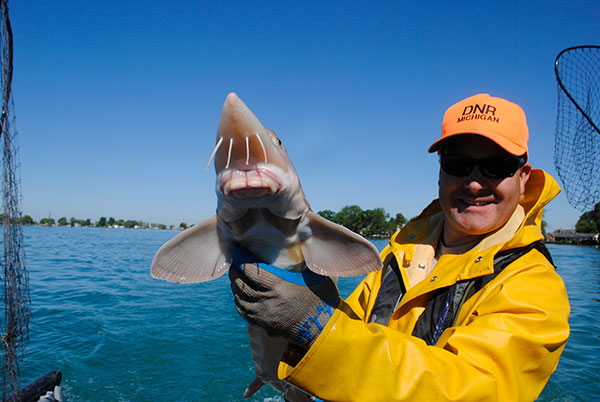- Details
(Provided by MDNR)
 Arctic GraylingThe Michigan Arctic Grayling Initiative, a statewide partnership effort focused on restoring self-sustaining populations of this native fish, unveiled its official action plan at a recent Natural Resources Commission meeting. The plan details the initiatives goals and various activities it plans to accomplish over the next several years.
Arctic GraylingThe Michigan Arctic Grayling Initiative, a statewide partnership effort focused on restoring self-sustaining populations of this native fish, unveiled its official action plan at a recent Natural Resources Commission meeting. The plan details the initiatives goals and various activities it plans to accomplish over the next several years.
This initiative, founded by the Michigan DNR and the Little River Band of Ottawa Indians, was announced in June 2016 and consists of 32 organizations.
The action plan is the result of multiple meetings of the partners where ideas, questions and information gaps were identified and then condensed into four main focus areas: research, management, fish production and outreach and education.
- Details
By BOB Gwizdz, MDNR
 Monitoring St. Clair Sturgeon Population Involves a Lot of Work
Monitoring St. Clair Sturgeon Population Involves a Lot of Work
Fisheries managers have many high-technology tools available today acoustic tracking, remote satellite imagery, environmental DNA that might make old-timers shake their heads and think it all sounds like science fiction.
But old-fashioned techniques continue to provide fisheries managers with data that helps them make management decisions that benefit both the fisheries resource and anglers.
Nowhere is this truer than when it comes to managing the Great Lakes oldest denizens lake sturgeon.
The Michigan DDNR has been monitoring sturgeon populations on the St. Clair River for the last 25 years with a technique that is as old as fishing itself.
DNR crews use set lines that are anchored to the bottom of the river channel and sport numerous hooks to catch and tag the mysterious prehistoric fish.
The DNRs research vessel, Channel Cat spent much of June on the North Channel of the St. Clair River, above Lake St. Clair, setting and running what are essentially trot lines to monitor the Great Lakes most significant sturgeon population.
"This is the largest natural reproducing population of sturgeon in the Great Lakes," said Todd Wills, who heads up the Lake St. Clair Fisheries Research Station. "We estimate the population in the St. Clair system at about 30,000 fish, 2 years old or older, with about 12,000 of them concentrated in the area being surveyed."
- Details
(Provided by MDNR)
The Michigan DNR Outdoor Skills Academy will offer bear hunting clinics in Cadillac, Michigan, Saturday, July 29, Saturday, Aug. 5, and Sunday, Aug. 6, from 10 a.m. to 4:30 p.m.
Students will learn the ins and outs of bear hunting with experienced hunters and DNR educators. The class will cover habitat, gear, stand placement, baiting, rules and regulations, carcass care and hide care.
Participants will spend three to four hours in the classroom and then hit the trail to learn how to place a stand and bait in the woods.
- Details
(Provided by MDNR)
The Michigan DNR announced environmental DNA sample results from the St. Joseph and Kalamazoo rivers show no signs of invasive silver and bighead carp.
According to DNR fisheries biologist Nick Popoff, none of the 260 DNA samples collected May 1 and analyzed by the U.S. Fish and Wildlife Service indicated the presence of genetic material for silver or bighead carp. Results and maps [ https://www.fws.gov/midwest/fisheries/eDNA/results/michigan/2017-06-30/2017-06-30.html ]of the 200 survey sites on the Kalamazoo River and the 60 sites on the St. Joseph River are available on the U.S. Fish and Wildlife Services Midwest Fisheries website.
The DNA surveillance program, a collaborative effort between the Great Lakes states and the U.S. Fish and Wildlife Service since 2013, samples high-priority locations for the presence of bighead and silver carp genetic material.
- Details
(Provided by MDNR)
The Michigan DNR reminds hunters that the fall turkey hunting application period opened Saturday (July 1).
Applications will be available through Aug. 1. The application fee is $5. Applications and licenses may be purchased at any authorized license agent or online at www.mdnr-elicense.com.
The 2017 fall turkey season runs Sept. 15 to Nov. 14. A total of 51,350 licenses are available, including 4,650 general licenses and 46,700 private-land licenses.
Information about fall turkey hunting can be found at www.michigan.gov/turkey. Fall turkey drawing results and leftover license availability also will be posted at this website Aug. 14.


